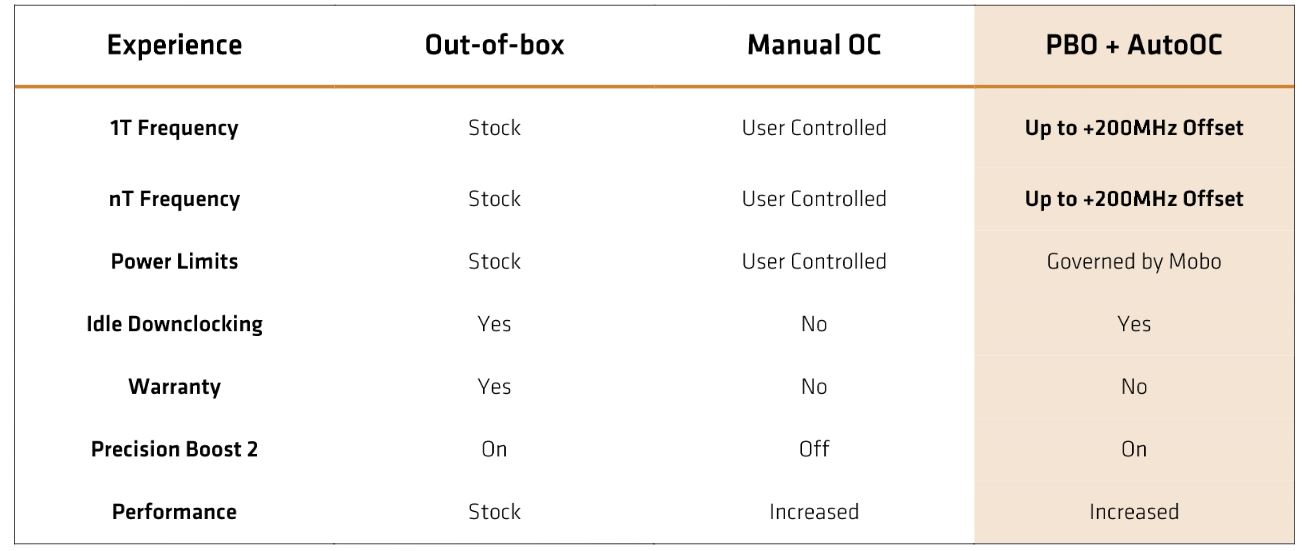AMD Ryzen 9 3900X and Ryzen 7 3700X Review: Zen 2 and 7nm Unleashed
Why you can trust Tom's Hardware
Precision Boost Overdrive, AutoOC, and Ryzen Master Software
AMD's Precision Boost Overdrive (PBO) is a boon to enthusiasts with its adaptive overclocking approach, and it's making its way from the Threadripper platform to all of AMD's Ryzen 3000 processors. The software allows the processor to communicate with the platform to modulate performance based on the motherboard's power delivery subsystem and thermal dissipation capabilities.
The processor monitors Package Power Tracking (PPT) and Thermal Design Current (TDC) variables, measuring available margin to the motherboard's maximum power output and current, respectively. Electrical Design Current (EDC) also indicates the maximum current possible from the VRMs during peak/transient conditions. A control loop feeds real-time telemetry data back to the processor, which then dynamically adjusts performance based on thermal and power conditions. AMD also exposes some of these monitoring features with its Ryzen Master overclocking software.
Motherboard vendors define the power limits for their boards and are developing custom profiles that support a new Auto OC feature. This new feature grants you some control over the maximum attainable boost clocks by allowing you to add up to an extra 200MHz to the maximum boost clock, but it isn't guaranteed that the processor will reach those speeds at all times, or under all conditions. Instead, the processor will still respect the limits imposed by the motherboard maker. AMD says that Auto OC is designed to improve performance in single-threaded workloads, while PBO boosts heavily-threaded applications. In either case, you can toggle both settings simultaneously for the best of both worlds.
Our Overclocking Efforts
Due to time constraints, we tested the Ryzen 9 3900X and Ryzen 7 3700X with both automated overclocking features activated instead of with a manual all-core overclock. Several motherboard vendors have told us that overclocking headroom is extremely limited on the Ryzen 3000 processors, and that exceeding the boost clocks, or even meeting them, isn't possible for all-core overclocking. Our resident overclocking expert Allen 'Splave' Golibersuch has also spent time with early Ryzen 3000 samples and was unable to break the 4.1 GHz barrier without sub-ambient cooling.
In either case, the combination of PBO and AutoOC yielded improvements in some applications, but wasn't as impressive with the Ryzen 7 3700X as it was with the Ryzen 9 3900X. In some cases, the boost confers no benefit for the Ryzen 7 3700X in our application testing, and on a few occasions, we see performance regressions in lightly-threaded workloads compared to the stock configuration. We tested with multiple motherboards and met with the same result, which could boil down to the quality of our sample or motherboard firmwares. As with most processor launches, motherboard firmwares are still a work in progress, so there is hope that the situation will improve. We'll update our results when a fix becomes available, but we did encounter this issue the night before NDA lift, so hopefully a fix will come soon.
We regularly observed our Ryzen 9 3900X maintaining an all-core 4.1 GHz during our testing, while the Ryzen 7 3700X often peaked at 4.125 GHz.
MORE: Best CPUs
MORE: Intel & AMD Processor Hierarchy
MORE: All CPUs Content
Get Tom's Hardware's best news and in-depth reviews, straight to your inbox.
Current page: Overclocking and Ryzen Master
Prev Page Ryzen 3000 IPC Measurements and Power Consumption Next Page Updated Test Metholodgy and Setup
Paul Alcorn is the Editor-in-Chief for Tom's Hardware US. He also writes news and reviews on CPUs, storage, and enterprise hardware.
